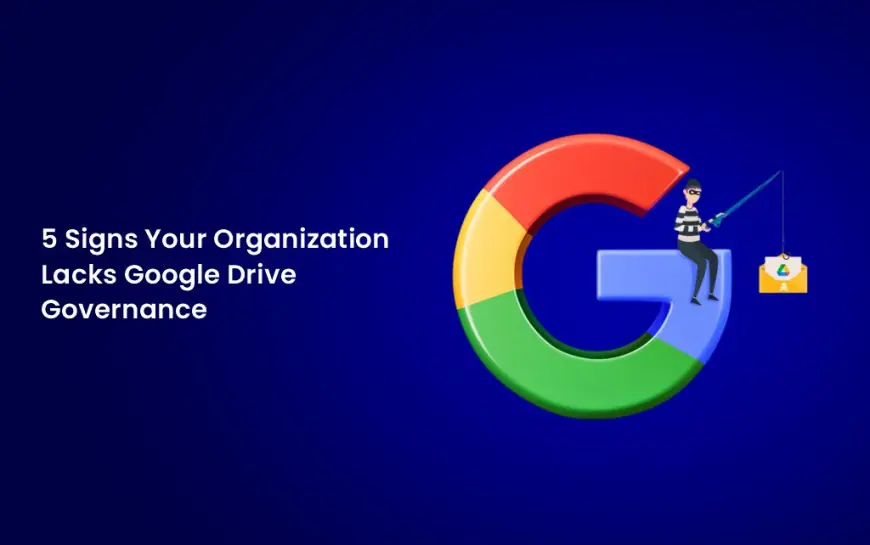5 Signs Your Organization Lacks Google Drive Governance
Discover 5 critical signs of poor Google Drive governance and learn how to address Google Drive security risks for better data protection.

Google Drive governance is vital for organizations relying on cloud storage in 2025. Without proper oversight, businesses face Google Drive security risks, compliance issues, and data breaches. This blog post highlights five telltale signs your organization lacks effective Google Drive governance. By recognizing these red flags and adopting Google Workspace governance tools, you can enhance Google Drive data protection, streamline file management, and ensure compliance.
Why Google Drive Governance Matters
Google Drive is a powerful tool for collaboration, but unmanaged file sharing can lead to chaos. Poor Google Drive governance exposes organizations to data leaks, regulatory fines, and operational inefficiencies. According to IBM’s 2025 Cost of a Data Breach Report, cloud-based data breaches cost businesses $4.88 million on average. Proper data governance in Google Drive mitigates these risks by enforcing access controls, monitoring activities, and ensuring compliance.
The Cost of Neglecting Governance
Neglecting Google Workspace file management can lead to severe consequences. Unauthorized access, shadow IT in Google Drive, and compliance violations are common pitfalls. Effective Google Drive governance ensures secure collaboration, protects sensitive data, and aligns with regulations like GDPR and HIPAA. Recognizing the signs of poor governance is the first step to addressing these challenges.
5 Signs Your Organization Lacks Google Drive Governance
Here are five critical indicators that your organization needs to strengthen its Google Drive governance practices.
1. Uncontrolled File Sharing
Unrestricted file sharing is a major Google Drive security risk. When employees share files externally without oversight, sensitive data can be exposed. For example, a 2024 study by Cybersecurity Insiders found that 65% of organizations reported data leaks due to improper file sharing. Without Google Drive access control, files may be shared with unauthorized users, increasing file sharing risks in Google Drive.
How to Address It
Implement tools like Patronum to enforce file-sharing policies. Set permissions to limit external sharing and use Google Drive audit logs to monitor activities. Regularly review shared links to prevent unauthorized access.
2. Lack of Access Control Policies
If your organization lacks clear Google Drive access control policies, sensitive files may be accessible to unintended users. For instance, employees might retain access to files after leaving the company. This oversight is a hallmark of poor document governance in Google Workspace, leading to potential data breaches.
How to Fix It
Use Google Workspace admin best practices to define role-based access controls. Tools like BetterCloud or Florbs can automate access revocation for former employees. Regularly audit permissions to ensure only authorized users have access.
3. Shadow IT Usage
Shadow IT in Google Drive occurs when employees use unauthorized apps or share files outside approved channels. This practice bypasses Google Drive user management, creating security and compliance gaps. A 2025 Gartner report estimates that 30% of cloud data breaches stem from shadow IT activities.
Solutions for Shadow IT
Deploy Google Workspace governance tools like ReShield to detect and block unauthorized apps. Educate employees on approved tools and monitor integrations using Google Drive audit logs to identify shadow IT risks.
4. Missing Audit Logs and Monitoring
Without Google Drive audit logs, organizations lack visibility into file activities. This gap makes it impossible to track who accessed or shared sensitive files, increasing Google Drive compliance issues. For example, failing to monitor file access can delay detection of insider threats or data leaks.
How to Improve Monitoring
Leverage Google Drive information security tools like Patronum or BetterCloud to enable real-time monitoring. Set up alerts for suspicious activities and review audit logs regularly to ensure compliance with regulations like GDPR.
5. Inadequate Data Loss Prevention Measures
If your organization lacks Google Drive data loss prevention (DLP) strategies, sensitive data is at risk. Without DLP, files containing personal or financial information can be shared or deleted accidentally. This is a critical Google Drive compliance issue, especially for regulated industries.
Implementing DLP
Use Google Drive data protection tools like Tresorit or Sync.com to implement DLP policies. These tools detect sensitive content, restrict sharing, and encrypt files. Additionally, train employees on data governance in Google Drive to minimize human errors.
The Consequences of Poor Google Drive Governance
Ignoring these signs can lead to severe repercussions. Data breaches, regulatory fines, and reputational damage are common outcomes. For instance, a 2025 Ponemon Institute study found that organizations with poor cloud governance faced 40% higher breach costs. Furthermore, lack of governance hampers productivity, as employees struggle with disorganized files and unclear permissions.
Real-World Example
In 2024, a healthcare provider faced a $1.2 million fine due to a Google Drive data breach caused by improper file sharing. The breach exposed patient data because of weak Google Drive access control. This highlights the need for robust Google Workspace management to prevent costly mistakes.
How to Strengthen Google Drive Governance
Addressing these signs requires proactive steps and the right tools. Here’s how to improve Google Drive governance in 2025.
Adopt Google Workspace Governance Tools
Tools like Patronum, Florbs, and BetterCloud streamline Google Drive user management and compliance. Patronum, for instance, automates access control and provides detailed audit logs, reducing Google Drive security risks by up to 50%, according to its 2025 user data.
Key Features to Look For
-
Automated Access Control: Restrict file access based on roles and revoke permissions automatically.
-
Real-Time Monitoring: Track file activities to detect anomalies instantly.
-
Compliance Support: Ensure adherence to GDPR, HIPAA, and CCPA with DLP and audit tools.
Follow Google Workspace Admin Best Practices
Implement these best practices to enhance document governance in Google Workspace:
-
Set Default Sharing Restrictions: Limit external sharing to approved domains.
-
Regular Audits: Use Google Drive audit logs to review access and sharing activities monthly.
-
Employee Training: Educate staff on secure file-sharing practices to reduce file sharing risks in Google Drive.
-
Enable Two-Factor Authentication (2FA): Add an extra layer of Google Drive information security.
Leverage Automation for Efficiency
Automation tools like Zenphi or Google Workspace Flows (expected in 2025) simplify Google Drive governance. They automate tasks like file organization, permission updates, and compliance checks, reducing human errors and saving time.
The Role of Google Workspace Governance Tools
Google Workspace governance tools are essential for addressing the signs of poor Google Drive governance. Here’s a closer look at how top tools help:
Patronum: Comprehensive Governance
Patronum leads the pack with its automation and compliance features. It offers real-time monitoring, automated access revocation, and DLP tools, making it ideal for Google Drive data loss prevention. Its user-friendly interface simplifies Google Workspace file management for admins.
BetterCloud: Security and Compliance
BetterCloud excels in detecting shadow IT in Google Drive and enforcing compliance. Its machine learning algorithms identify unusual file activities, ensuring robust Google Drive information security.
Florbs: Access Control and Automation
Florbs automates access control and file-sharing policies, reducing Google Drive compliance issues. Its reporting tools provide insights into file exposure, helping admins address vulnerabilities quickly.
The Future of Google Drive Governance
In 2025, Google Drive governance is evolving with AI and automation. Tools like Google Workspace Flows will introduce native automation, while AI-driven solutions like Patronum will enhance file sorting and risk detection. Staying ahead requires adopting these technologies to address Google Drive security risks proactively.
Emerging Trends
-
AI-Powered Governance: AI will predict and prevent file-sharing risks.
-
Zero Trust Security: Tools will enforce stricter Google Drive access control based on zero trust principles.
-
Integrated Compliance: Governance tools will align with global regulations seamlessly.
Conclusion
Poor Google Drive governance can lead to data breaches, compliance violations, and operational inefficiencies. The five signs—uncontrolled file sharing, lack of access control, shadow IT, missing audit logs, and inadequate DLP—signal the need for immediate action. By adopting Google Workspace governance tools like Patronum, BetterCloud, and Florbs, organizations can strengthen Google Drive data protection, ensure compliance, and enhance collaboration. Start implementing Google Workspace admin best practices today to secure your cloud environment.
FAQs
What is Google Drive governance?
Google Drive governance involves managing file access, sharing, and compliance to ensure data security and regulatory adherence in Google Workspace.
How can I identify Google Drive security risks?
Look for signs like uncontrolled sharing, missing audit logs, or shadow IT. Tools like Patronum provide real-time insights into these risks.
Why is Google Drive data loss prevention important?
DLP prevents sensitive data leaks by restricting unauthorized sharing and detecting risky content, ensuring compliance with regulations.
What are the best tools for Google Drive governance?
Patronum, BetterCloud, and Florbs are top choices for automating access control, monitoring, and compliance in Google Drive.
How can I improve Google Drive access control?
Use role-based permissions, automate access revocation with tools like Patronum, and review Google Drive audit logs regularly.
What's Your Reaction?
 Like
0
Like
0
 Dislike
0
Dislike
0
 Love
0
Love
0
 Funny
0
Funny
0
 Angry
0
Angry
0
 Sad
0
Sad
0
 Wow
0
Wow
0


















































